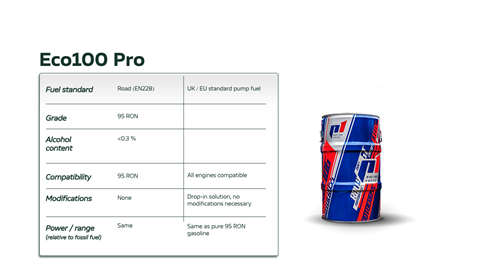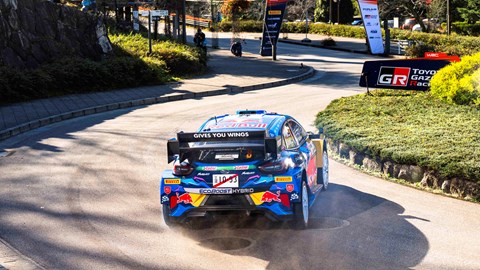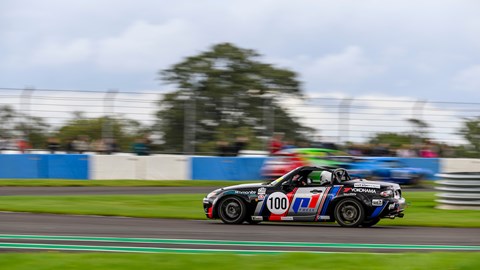► Synthetic fuels could replace fossil fuels
► Potential to be carbon-neutral from well to wheel
► We race Mazda MX-5 running P1 synthetic fuels
The age of the electric car is truly upon us, but what does that mean for motorsport? We’ve seen all-electric racing series such as Formula E and Extreme E and while both have attracted big name drivers and teams, both have their limitations.
So what’s the alternative? Well, one could be synthetic fuels. With the potential to be completely carbon-neutral and able to drop straight into existing racing cars, it sounds extremely promising – but does it work in reality?
We entered a Mazda MX-5 into a two-hour 750 Motor Club endurance race to find out.
How does synthetic fuel work?
The particular synthetic fuel that we’re using is Eco100Pro made by P1 Fuels. It’s 97 octane and EN228-accredited yet, in this form, is 94% (6% shortfall a result of not all energy in the process coming from renewables) carbon-neutral from well to wheel. P1 already supplies fuel to the WRC (World Rally Championship) and is an established player in the industry.

By using components for fuel created via either alcohol to gasoline method or direct air capture for CO2, P1 can essentially manufacture fuel by using carbon that’s already in the atmosphere.
So when the inevitable tailpipe emissions are produced by combustion in the regular cylinder engine, they’re not adding to net CO2 and thus not polluting the atmosphere further. Its maker claims 100% carbon-neutral is a realistic target.
What are the downsides?
Understandably, the current cost of the fuel per litre is around three times as much as unleaded petrol. However, industry forecasts suggest that, within the next three years, the price could reduce to a comparable level as scalability improves.

Critics of synthetic fuel will also point out that it doesn’t stop localised pollution and thus wouldn’t solve air quality issues seen in cities throughout the world. However, advocates for synthetic fuels highlight that the technology is designed to work in tandem with (rather than replace) other solutions – such as electrification – to bring down global CO2 levels. Indeed, the WRC reported a 512-tonne reduction in CO2 in 2022 as a direct result of switching to synthetic fuels.
Did the fuel work in the race?
It did, brilliantly in fact. The power output appeared normal, delivery was super smooth and responsive and the engine didn’t skip a beat. In other words, it behaved just like a regular unleaded petrol racing car should. Unfortunately, the gearbox (unrelated to the fuel) had other ideas.
We (myself and car owner and P1 Fuels advocate Matt Simmonite) qualified P3 in class (out of about 8 cars) in the wet, which – given it was my first time in the car – I was very pleased with. Come the race and we knew that we wouldn’t be quite as competitive in the dry, yet this was a two-hour race and everything was to play for…

However, about five laps in I noticed the clutch pedal was beginning to stick to the floor and then, worse, I lost most forward gears. Cue a careful crawl back to the pits (if you’ve ever been stuck on the outside lane of a fast-moving motorway you’ll have an idea of what this is like) and the unfortunate retirement of the car.
Verdict
The fossil-free fuel and the science behind it clearly works. We know this not just from the race at Donington, but also the countless other tests and projects involving the fuel – not least the World Rally Championship. The challenge behind rolling it out into the mainstream therefore is not so much technical, but political.
Major hurdles to overcome include the price – it needs to become cheaper – and the inevitable battle against the perception that synthetic fuels are intended to replace electrification and that there must be a choice between one or the other. This should not be the case as, realistically, neither are without their flaws. The current challenges with EVs are well-documented while synthetic fuels still produce localised pollution and need to drastic scaling up to be competitively priced. However, if both are allowed to work together, synthetic fuels can play a vital role in the battle against rising CO2 levels.
Furthermore, the case for synthetic fuels in motorsport – especially grass-roots level – is compelling, with EVs unlikely to offer a cost-effective form of racing in the near future. As ever, it’s on the racetrack (or indeed the rally stages of the world) where the technology can be proven and projected to a wider audience.
Trackside photos by Jon Elsey